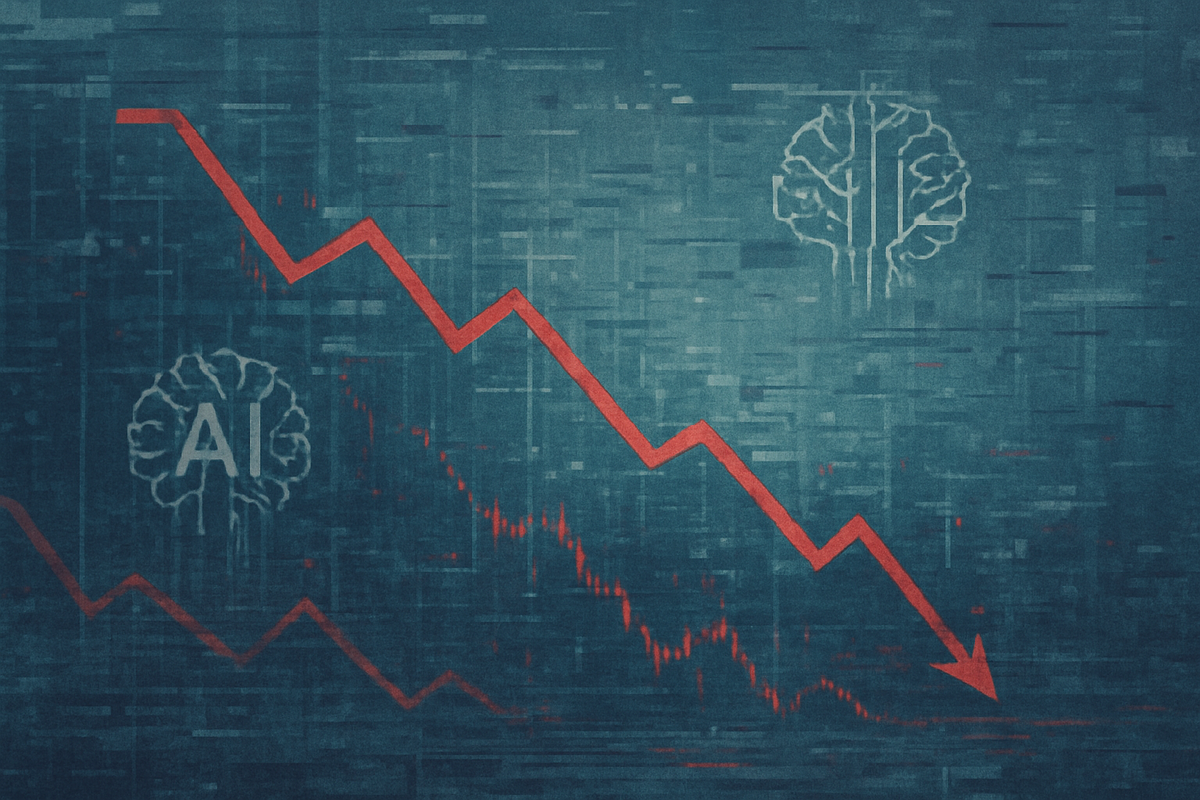
The technology sector of the S&P 500 experienced a tumultuous trading day on November 18, 2025, as a potent cocktail of "AI jitters," a broad "stocks selloff," and escalating concerns over "AI valuations" triggered a significant underperformance. This market downturn saw several tech giants, notably Amazon (NASDAQ: AMZN), bear the brunt of investor apprehension, signaling a potential shift in the market's seemingly insatiable appetite for AI-driven growth. The day's events highlight a growing skepticism regarding the sustainability of the current AI boom and the lofty valuations attached to companies at its forefront.
The immediate implications are a noticeable cooling in investor sentiment towards technology stocks, particularly those heavily invested in or benefiting from artificial intelligence. What began as a broad market retreat, extending a multi-day losing streak for major indices, was acutely felt in the tech sector, where the narrative of unbridled AI expansion is now facing rigorous scrutiny. This underperformance is not merely a blip but suggests a deeper re-evaluation of fundamental strengths and future prospects amidst an increasingly cautious economic outlook.
Detailed Coverage: A Day of Reckoning for Tech Giants
November 18, 2025, unfolded as a critical day for the technology sector, with a confluence of factors culminating in a steep decline. The S&P 500 (INDEXSP: .INX) was already on track for its fourth consecutive daily loss, reflecting a broader "risk-off" sentiment fueled by doubts surrounding potential interest rate cuts by the Federal Reserve and weakness in European and Asian markets. However, the technology sector's woes were amplified by specific anxieties surrounding artificial intelligence.
A prevailing sense of "AI jitters" permeated the market, as investors began to question the long-term sustainability of the AI boom that has dominated headlines and driven valuations for months. Concerns mounted over whether the accelerated pace of AI spending could genuinely be maintained, leading to speculation about an impending bubble. This skepticism was further fueled by prominent figures in the financial industry. Daniel Pinto, Vice Chairman of JPMorgan Chase (NYSE: JPM), publicly stated that AI valuations required re-examination and warned of a potential "correction" that could ripple across the broader stock market. Similarly, Alphabet (NASDAQ: GOOGL) (NASDAQ: GOOG) CEO Sundar Pichai acknowledged "elements of irrationality" in the current AI surge, drawing parallels to the "irrational exuberance" that preceded the dot-com bust. Analysts pointed to historically high price-to-earnings (P/E) and Cyclically Adjusted Price-to-Earnings (CAPE) ratios in the technology and AI sectors as unsustainable.
Among the key players, Nvidia (NASDAQ: NVDA), the chipmaking giant often seen as the bellwether for AI, was a significant drag on the market, with its shares losing further ground ahead of a crucial earnings report. The company's stock entered "correction territory," having fallen more than 10% for the month. Amazon (NASDAQ: AMZN) was particularly hard-hit, with its shares trading lower by over 4% on November 18. Rothschild & Co Redburn downgraded Amazon to "neutral" from "buy," citing a more cautious outlook on Amazon Web Services (AWS) and suggesting that while Amazon has succeeded with AI, the potential for significant upside relative to buyer expectations might be limited. The report also raised concerns that the often unprofitable development of general AI could dilute returns for the e-commerce giant. Amazon's stock also entered "correction territory," falling more than 12% from its recent peak, with its recent $15 billion debt deal, partially aimed at financing AI ambitions, adding to investor worries about excessive AI-related debt. Microsoft (NASDAQ: MSFT) shares also traded lower and were subject to a downgrade by Rothschild & Co Redburn. AMD (NASDAQ: AMD) and Meta Platforms (NASDAQ: META) also saw declines, with Meta's stock already in a bear market.
Companies Navigating the AI Headwinds
The recent market shift has created a clear divide between potential winners and losers, reshaping the landscape for public companies heavily invested in or reliant on the AI narrative. Companies with robust, diversified revenue streams and tangible, immediate profitability from AI applications may weather the storm better, while those with speculative AI ventures or inflated valuations face significant headwinds.
Potential Losers: Companies like Nvidia (NASDAQ: NVDA), despite its foundational role in AI hardware, are vulnerable to "AI jitters" due to its elevated valuation and direct exposure to the pace of AI infrastructure spending. Any slowdown in demand or re-evaluation of future growth projections could disproportionately impact its stock. Amazon (NASDAQ: AMZN) also falls into this category, as concerns mount over the profitability of its AI development, particularly within AWS. The substantial investment in AI, coupled with a cautious outlook from analysts, suggests that the market is scrutinizing whether these expenditures will yield commensurate returns, rather than diluting overall profitability. Other companies with significant, yet unproven, AI initiatives or those that have seen their stock prices surge primarily on AI hype, without a clear path to monetization, are also at risk. This includes many smaller AI startups and some larger tech firms that have heavily pivoted towards AI without demonstrating consistent profitability from these ventures.
Potential Winners (or those more resilient): Companies with a more conservative approach to AI valuations, or those that leverage AI to enhance existing, profitable business lines without incurring excessive debt or speculative spending, might prove more resilient. For example, some established software companies that integrate AI to improve their core offerings, rather than betting entirely on novel AI products, could see less volatility. Additionally, companies providing essential, non-speculative infrastructure or services that enable AI development, but are not directly exposed to the high-flying valuations of AI models themselves, might fare better. Furthermore, companies with strong balance sheets and diversified revenue streams that allow them to absorb the costs of AI research and development without jeopardizing overall profitability are in a stronger position. The current environment might also benefit companies that can demonstrate clear, immediate, and measurable ROI from their AI investments, distinguishing themselves from those with more speculative ambitions.
Wider Significance: A Reassessment of the AI Paradigm
The current tech sector downturn, driven by "AI jitters" and valuation concerns, represents a significant moment of reassessment for the broader industry. For months, the narrative surrounding artificial intelligence has been one of unbridled growth and transformative potential, driving record valuations and a surge in investment. This event signals a maturation of the market's perspective, moving beyond initial hype to a more critical examination of fundamental value and sustainable growth.
This re-evaluation fits into broader industry trends, particularly the historical cycles of technological innovation. Much like the dot-com bubble of the late 1990s, periods of intense technological enthusiasm often lead to speculative excesses before a more realistic market equilibrium is found. The comments from industry leaders, drawing parallels to "irrational exuberance," underscore this historical context. The ripple effects are likely to be felt across competitors and partners. Companies heavily reliant on the AI spending of tech giants may see a slowdown in demand, while those with more conservative balance sheets and clear AI monetization strategies might gain a competitive edge. This could lead to a consolidation within the AI space, favoring established players with deep pockets and proven track records over nascent startups. Regulatory or policy implications could also emerge as governments scrutinize the potential for market bubbles and the broader economic stability risks associated with highly concentrated technological sectors. Discussions around antitrust and market dominance in the AI space, already present, could intensify.
Historically, such periods of market correction in a dominant sector often precede a flight to quality. Investors may shift capital towards companies with stronger fundamentals, clearer profit paths, and more tangible returns, even if they are not at the cutting edge of AI innovation. This current event could mark the beginning of a more disciplined investment environment for AI, where demonstrable value creation takes precedence over speculative growth projections.
What Comes Next: Navigating the New AI Reality
The immediate future for the technology sector, particularly for AI-centric companies, is likely to be characterized by increased volatility and a more discerning investment landscape. In the short term, we can expect continued pressure on highly valued AI stocks as investors recalibrate their expectations and scrutinize earnings reports for concrete evidence of profitability and sustainable growth. This period may also see a rebalancing of portfolios, with a potential shift away from pure-play AI companies towards those that demonstrate a more integrated and profitable application of AI within diversified business models.
In the long term, this market correction could foster a healthier and more sustainable AI ecosystem. Companies will be compelled to focus more intensely on tangible returns on investment for their AI initiatives, rather than simply pursuing growth at any cost. This could lead to strategic pivots, with some companies streamlining their AI research, prioritizing projects with clearer commercial viability, or even divesting from speculative ventures. For others, it presents an opportunity to acquire undervalued AI talent or technologies from struggling competitors. Market opportunities may emerge for investors willing to undertake thorough due diligence and identify companies with genuinely disruptive AI technologies backed by sound financials. Challenges will include navigating a more cautious funding environment for AI startups and demonstrating clear differentiation in a crowded market. Potential scenarios range from a prolonged period of consolidation and rationalization within the AI sector to a more rapid rebound for companies that successfully adapt and prove their value proposition.
Wrap-Up: A Call for Prudence in the AI Era
The significant underperformance of the S&P 500's technology sector on November 18, 2025, driven by "AI jitters" and concerns over "AI valuations," serves as a crucial inflection point. It underscores the market's evolving sentiment, moving from an era of unbridled optimism to one of cautious scrutiny regarding the AI boom. The key takeaway is that while artificial intelligence undoubtedly holds immense transformative potential, its financial implications are now being subjected to a more rigorous and realistic evaluation.
Moving forward, the market is likely to prioritize companies that can demonstrate not just innovation, but also profitability and sustainable business models in their AI endeavors. The days of speculative investments based solely on future potential may be waning, replaced by a demand for tangible returns and disciplined capital allocation. Investors should watch for several key indicators in the coming months: the earnings reports of major tech companies, particularly those with significant AI exposure, for signs of profitability and realistic guidance; analyst revisions and downgrades, which will signal shifts in expert sentiment; and broader macroeconomic data, which will influence overall market liquidity and risk appetite. Ultimately, this period represents a necessary recalibration, ensuring that the AI revolution is built on a foundation of sound financial principles rather than speculative exuberance, thereby paving the way for more sustainable growth in the long run.
This content is intended for informational purposes only and is not financial advice






